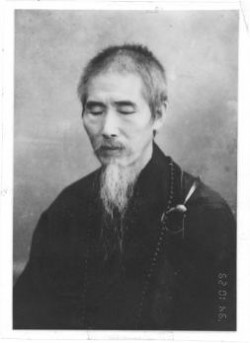Hua-tou style meditation is beginning to come back into practice in the Buddhist community.
It was the favorite style of Ch’an Master Xu Yun, who is my teacher’s teacher’s teacher. Xu Yun spent much of his 120 year life advocating Hua-tou practice as the most direct path to Enlightenment.
There are much more popular meditation techniques: gong-an (koan) practice, following the breath, chanting or listening to a gong.
These are fine, but Hua-tou is set apart because it is designed to make us look directly into the nature of our being.
Hua-tou is designed to be practiced not just during our time on the meditation cushion, but throughout the day. In that way, it’s similar to gong-an practice.
We must have a sincere motivation to pursue this practice. This is not a practice for the casual meditator, but rather for one who is determined to become enlightened.
Also, we must have cultivated an ability to concentrate and hold onto an idea with our minds without being distracted.
For this reason, it’s recommended to have a pretty solid breath counting meditation practice or some other simple form of meditation before beginning the Hua-tou.
The literal translation of Hua-tou is word head. It refers to the origin of our thoughts.
Hua-tous are questions we ask ourselves over and over. For example:
Who is dragging this body around?
What is this?
Who am I?
What was my face before my parents were born?
Hua-tou practice involves looking deeply into ourselves by asking a question and then returning to the question over and over. Our goal isn’t to answer it, but only to train our minds in a certain way, to prepare our minds for the experience of Awakening.
If you think you’re ready to begin the practice, here are the rules:
1. Select a hua-tou.
Often students have their teachers choose a hua-tou for them. That’s helpful, but not completely necessary. Unless your teacher knows you very well, you are probably the best judge of a good hua-tou for yourself. Once you choose your hua-tou, don’t change it. If you’re worried you picked the wrong one, don’t be.
Ultimately they are all the same, if you penetrate the hua-tou deeply enough.
2. Start using this hua-tou in your regular meditation period.
By the way, please have a regular meditation practice. Whether it’s once a day or once every two days or once a week. The point is routine. Don’t let yourself make excuses to not do it. Routines are difficult to cultivate and easy to lose.
3. Practice your hua-tou throughout the day.
Do it while driving, taking out trashing, walking the dog and other normal activities. It works best when you’re doing it during activities that don’t require your complete attention. The amount of effort it takes to bring your mind back to the hua-tou will lessen as time goes on.
4. Notice the results.
Over time your attention will become stronger and your awareness will become more expansive. Noticing these changes helps us to stick with the practice, just like noticing the results of working out does. Also, the practice itself changes.
The Hua-tou will take on new meanings over time if you stick with it.
Love elephant and want to go steady?
Sign up for our (curated) daily and weekly newsletters!
~
~
Author: Daniel Sharpenburg
Editor: Ashleigh Hitchcock
Photo: media library












Read 1 comment and reply